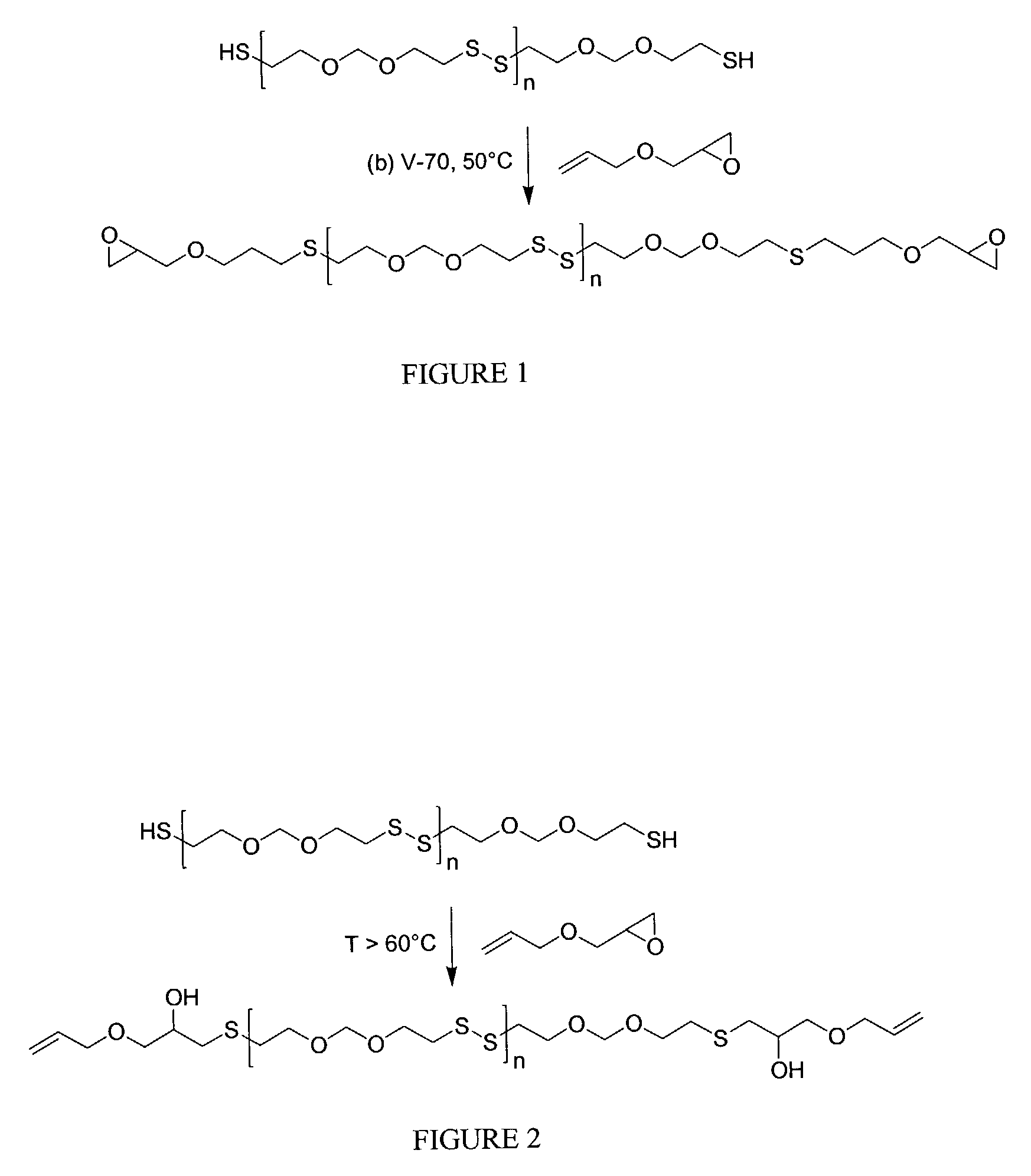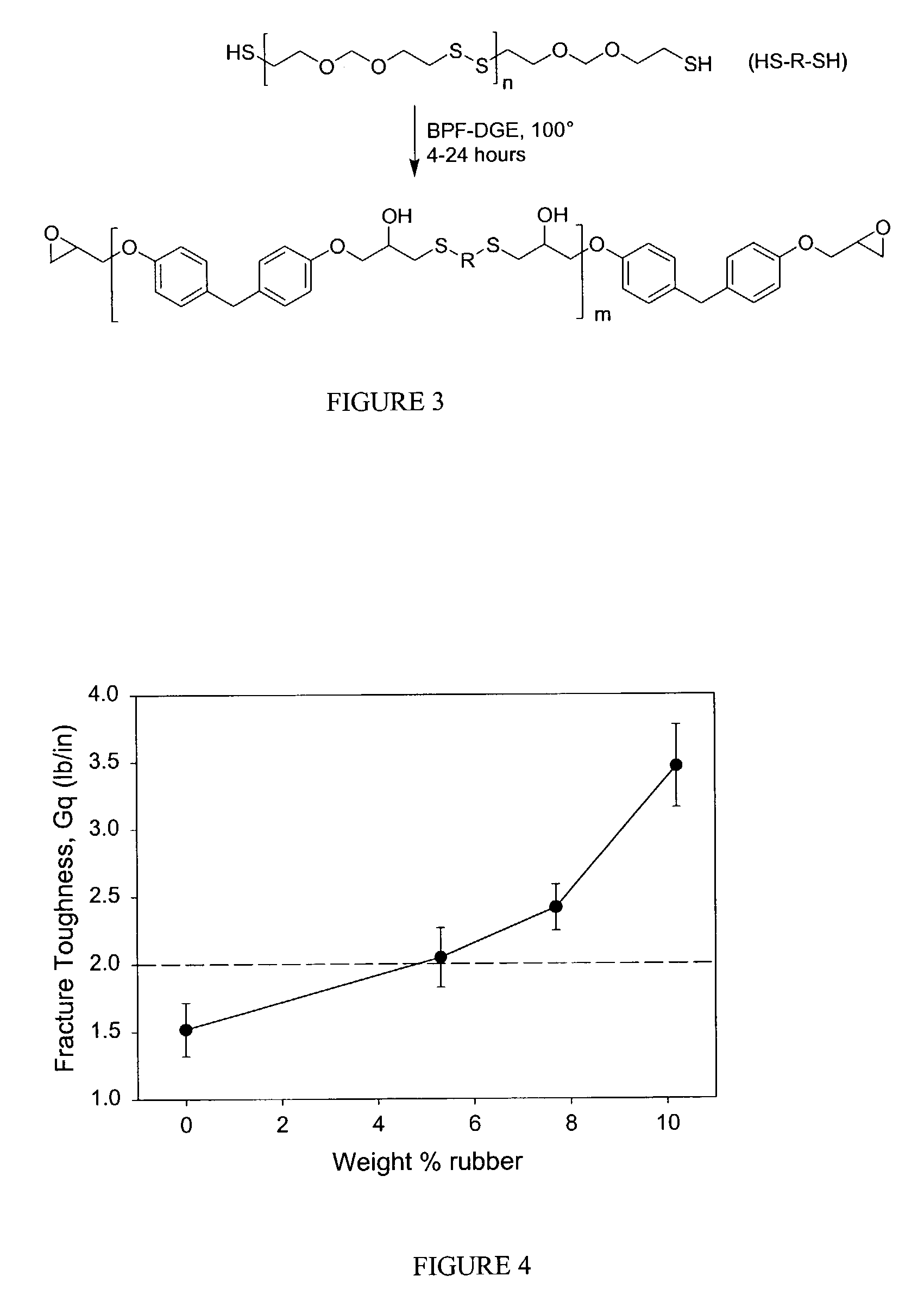Polysulfide-based toughening agents, compositions containing same and methods for the use thereof
a polysulfide-based, toughening agent technology, applied in the direction of synthetic resin layered products, semiconductor/solid-state device details, transportation and packaging, etc., can solve the problems of poor fracture toughness, brittleness of glassy epoxy resins with relatively high tsub>g/sub>(>100° c.) and improve the performance of epoxy-based adhesive formulations. , the effect of improving the toughness and improving the hardness
- Summary
- Abstract
- Description
- Claims
- Application Information
AI Technical Summary
Benefits of technology
Problems solved by technology
Method used
Image
Examples
example 1
Synthesis of Epoxidized Polysulfide by Radical Addition of AGE
[0112]The subject reaction was conducted neat using stoichiometric amounts of AGE and polysulfide, a typical synthesis procedure using polysulfide G4 is as follows. To a 250 mL three-neck round bottom flask fitted with magnetic stirrer and nitrogen inlet, was added allylglycidyl ether (AGE; 22.280 g; 0.2 equivalents of epoxide) and Thioplast G4 polysulfide (90.958 g; 0.2 equivalents of thiol). The mixture was stirred to give a homogeneous solution, then 2,2′-azobis(4-methoxy-2,4-dimethylvaleronitrile) (V-70; t1 / 2=30° C.; 1.284 g; 1% by weight of total reactants) was added and dissolved. The headspace was swept with nitrogen and the stirred solution heated. At 45° C. gas evolution was observed and heating was continued at 45–55° C. for 4 hours at which time gas evolution was completed. The crude product was then heated at about 60° C. for 1 hour, followed by vacuum stripping for 1.5 hours until all the volatile components ...
example 2
Alternate Method for Preparation of Epoxidized Polysulfides
[0120]An alternate method was examined for the production of epoxidized polysulfides, involving the telechelic step-growth polymerization of thiol-terminated polysulfides with excess bisphenol F diglycidyl ether (BPF-DGE). The reaction is outlined in FIG. 3. A typical procedure is as follows: Thioplast G4 polysulfide (28.982 g; 0.06 equivalents of thiol) and bisphenol F diglycidyl ether (RE-404) (30.528 g; 0.196 equivalents of epoxide) were added to a 100 mL three-necked round bottom flask fitted with a thermocouple and magnetic stirrer. The mixture was heated at 100° C. for 5 hours to give the epoxy terminated extended polymer as a viscous liquid (57.106 g; 96% yield; EEW=419 g; viscosity at 25° C.=57,000). 1H NMR (CDCl3): δ=3.30, m, 2H, —OCH2CH— of epoxide group; IR (ATR); OH group 3476 cm−1.
[0121]Thus, the reaction was conducted by heating a neat mixture of polysulfide and excess epoxy monomer at 100° C. It was performed ...
example 3
Preparation of Prototype Underfill Adhesive Formulations
[0124]Bisphenol F diglycidyl ether epoxy monomer (RE404; Nippon Kayaku Co.), toughening agent, Co(AcAc)3 (added as 1% premix in RE404), Unilink 4100 (UOP Inc.; N,N′-bis-isobutyl-p-phenylenediamine), A-137 (OSI Specialities; octyl triethoxy silane) and silica (SO-E5; Admatechs Co) were blended together using a mechanical mixer and vacuum treated at room temperature for about 30 minutes to remove small amounts of volatile materials present in the A-137 silane. The mixture was then heated to 100° C. (to promote silylation of silica filler) and cooled to room temperature. A-1100 silane (OSI Specialties; 3-aminopropyl triethoxysilane) and imidazole catalyst (2-propylimidazole; Actiron NXJ-60; Synthron Inc) were then added and the mixture stirred for a further 10 minutes. The composition was vacuum treated to remove air bubbles and used immediately or stored at −20° C. until needed.
[0125]Fracture toughness tests were conducted on sev...
PUM
| Property | Measurement | Unit |
|---|---|---|
| Temperature | aaaaa | aaaaa |
| Temperature | aaaaa | aaaaa |
| Time | aaaaa | aaaaa |
Abstract
Description
Claims
Application Information
 Login to View More
Login to View More - R&D
- Intellectual Property
- Life Sciences
- Materials
- Tech Scout
- Unparalleled Data Quality
- Higher Quality Content
- 60% Fewer Hallucinations
Browse by: Latest US Patents, China's latest patents, Technical Efficacy Thesaurus, Application Domain, Technology Topic, Popular Technical Reports.
© 2025 PatSnap. All rights reserved.Legal|Privacy policy|Modern Slavery Act Transparency Statement|Sitemap|About US| Contact US: help@patsnap.com



